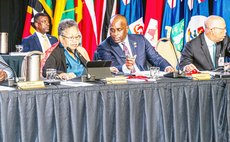Lessons from Guyana and Norway
Forests are crucially important to climate change. According to the Food and Agriculture Organisation (FAO), "they have the potential to absorb about one-tenth of global carbon emissions projected for the first half of this century into their biomass, soils and products and store them - in principle in perpetuity".
By the same token, the FAO points out that where forests have been cleared, overused or degraded, they contribute about one-sixth of global carbon emissions.
Clearly, then, it is in the interest of the planet as a whole that forests be preserved.
This is, in part, why in November 2009 the government of Norway signed an agreement to provide the government of Guyana up to US$250M by 2015 to avoid deforestation.
The agreement between the two governments specifically recognized that "Sustainable, low-carbon development is essential if global warming is to not increase by more than 2°C above pre-industrial levels. Given the significant contribution of emissions from deforestation and forest degradation to climate change, and the real risk of increased pressure on forests in currently low-deforesting countries as rates in currently high-deforesting countries are decreased, the Participants consider it crucial that all tropical forest countries, both high - and low- deforesting countries, are given incentives to reduce and avoid emissions from deforestation and forest degradation".
The problem with the agreement is that it placed the responsibility for disbursing the Norwegian monies to Guyana in the control of the World Bank and other implementing agencies whose criteria delays payments and imposes a costly level of bureaucracy.
For countries, such as Guyana, that are rightly eager to utilise their natural resources to develop their economies and improve the living conditions of their people, delays in the provision of financial resources to preserve forests have to be balanced against what the country could have earned from forestry and other extractive industries which, inevitably, would have caused forest degradation.
The present agreement between the two governments will end this year. No doubt both Norway and Guyana will be considering ways of keeping the agreement – or elements of it - in place. To be fair to Norway, it has reaped no gain for itself alone; the benefits of the agreement have redounded to the world as the Guyana forests absorb and trap CO2 emissions from polluters elsewhere. Of course, the preservation of the forests has also stopped even more CO2 from being released into the world's atmosphere.
Significantly, in the agreement the two countries had envisaged encouraging "other developed countries to contribute to the Fund as part of their efforts to combat climate change".
But, other industrialised nations have not followed the pattern set by Norway. No other countries sought to join the effort in Guyana or to provide funding to other countries to maintain their forests. Further, intermediary organisations, have imposed criteria that were not envisaged in the agreement. Therefore, payments have failed to address pressing issues such as alleviating poverty and improving health care.
If industrialised nations were genuinely interested in preserving forests in developing countries, many of them should have followed Norway's example, and committed themselves to doing so in the Conference of the Parties (COP) on Climate Change and other meetings that have been on-going for years. What is more, they should have created a mechanism for financing such commitments.
It is now evident that the idea of "carbon trading" between high emitting and low emitting countries was nothing more than a sop to environmentalists and developing countries. The failure to realise "carbon trading" gives greater strength to the call for a tax on the carbon emitted by companies worldwide with exemptions for those in countries whose emissions is very low.
Norway itself should have developed with Guyana a mechanism for making payments, against strict monitoring, regulation and measurements that did not include the general and restrictive rules set by these intermediary organisations.
Because of its considerable forests, Guyana has been a leader in developing a low carbon strategy for development. Part of that strategy is the preservation of its forests. In implementing the strategy, the country has demonstrated considerable international responsibility.
Of course, there are other countries in the 15-nation Caribbean community (CARICOM), of which Guyana is a member, that also have forests though none of them as large as Guyana's. Belize, Dominica and Jamaica also have forests that should be preserved. It is only a question of time before these countries have to make a choice between earning incomes from forestry operations and showing international conscientiousness by leaving their forests intact. In the absence of international help to preserve the forests, they might well have to opt for the former.
The degradation of forests in almost every Caribbean country preceded the destruction of forests in the United States. When the Caribbean islands, such as Antigua, Barbados, Haiti and Jamaica, were colonised by European settlers, they were thick with forest cover that was systematically destroyed to grow indigo, tobacco and eventually sugar. In many of these islands, the harmful effects of deforestation has stretched over centuries.
For example, Antigua has suffered from extensive periods of drought lasting years in some instances, crippling agriculture and causing expensive investment in desalinised water. An official of the water authority there has said that 70% of the country's water now comes from desalination, and "based on climate trends" the country may soon have to become fully reliant on desalination for water – an expensive proposition for households, the tourism industry and manufacturing.
Reforestation and the preservation of existing forests should be pursued by Caribbean countries in the Climate Change meetings scheduled this year and culminating in Paris in November. Maintaining forests serves the interest of the countries in which they are located and all of mankind.
The Norway-Guyana model is not perfect, nor was it expected to be, but it exists and does provide a framework for other such agreements that follow. There are lessons that can be learned from it in establishing North-South co-operation to maintain and rebuild forests that are precious to the well-being of the planet.
Responses and previous commentaries: www.sirronaldsanders.com
(Sir Ronald Sanders is a Senior Fellow at the Institute of Commonwealth Studies, London University and a former Caribbean diplomat)




